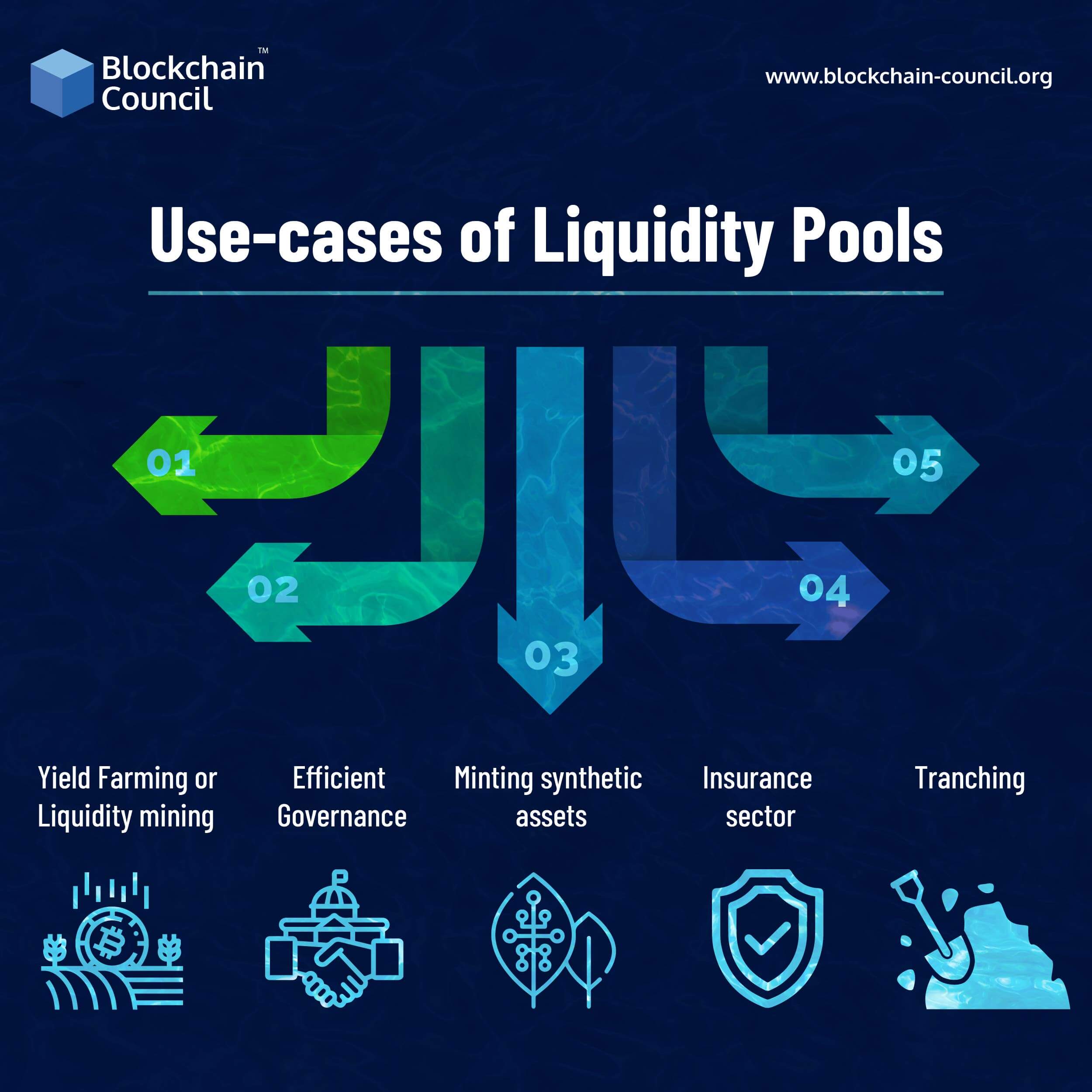
- Avinandan Banerjee
- January 03, 2022

Crypto Liquidity Pools are an essential part of the DeFi ecosystem. These pools are a collection of tokens or digital assets stored in a smart contract. These pools, among other things, help to facilitate decentralized trading and reduce the danger of washout.
The core technology behind the current DeFi ecosystem is liquidity pools. They form a fundamental piece of yield farming, lend-borrow protocols, automated market maker (AMM), engineered resources, on-chain protection, blockchain gaming, and so on.
Let’s dive further into the crypto liquidity pools concept.
Understanding the meaning of liquidity pools
Liquidity pools are stored crypto assets to make trading of major exchanges on DEX (decentralized exchanges) easier.
- Liquidity pools are reserves of tokens secured in smart contracts.
- They provide liquidity in DEX, attempting to mitigate the problems caused by the illiquidity in such systems.
- The convergence of orders, establishing price quotations (if reached) decide whether the asset will continue to surge or decline, are also referred to as liquidity pools.
- The same DEX that uses crypto liquidity pools uses AMM (automated market maker) approach. Such exchange platforms have the feature to replace conventional order books with pre-funded on-chain liquidity pools for both assets of the trading pair.
- Bancor was one of the first protocols to use liquidity pools, but the concept gained traction after Uniswap became popular.
- SushiSwap, Balancer, and Curve are among popular Ethereum exchanges that leverage liquidity pools. These venues’ liquidity pools contain ERC20 tokens.
- BakerySwap, PancakeSwap, and BurgerSwap are Binance Smart Chain (BSC) analogues, with pools containing BEP20 tokens.
Mechanism of crypto liquidity pools
The ease with which you can change your crypto to fiat currency or another asset without affecting its price is known as liquidity in cryptocurrency. This implies that you can immediately convert your bitcoin or any other crypto asset to a reasonable cash value.
Let us understand how this works:
- Two tokens or cryptocurrencies constitute a liquidity pool. For a pair of tokens, pools generate multiple markets.
- The pool’s creator determines each asset’s initial price. However, if the pool’s pricing does not match that of the global crypto market, the liquidity provider risks losing money.
- As more providers contribute funds to the pool, it’s critical to keep tokens in line with market pricing.
- The pricing algorithm is responsible for adjusting the asset price, as the liquidity pool supports token swaps. The value could be calculated by each liquidity pool using its own methodology.
- Regardless of the magnitude of trade, the algorithm ensures that the pool is always liquid and is known as Automated Market Makers (AMMs).
- The token ratio determines the pool’s pricing. For example, when someone buys DAI from the DAI/ETH pool, the volume of ETH increases, raising the price of DAI while lowering the price of ETH.
- The total price adjustment will depend on how much the person spent and how much the pool was altered.
- Because massive trades and purchases are required for changes to occur, larger pools exhibit fewer variations.
- The transaction fees that others pay to buy and sell from the pool pay the liquidity providers. Those transaction fees are reinvested in the liquidity pool, helping to boost the value of your tokens and expand the pool.
Established liquidity pools can have approximately $1 million invested in them, making them relatively stable for novice crypto traders. Smaller pools are more vulnerable to market swings, which might result in a drop in the value of your tokens. Nevertheless, you can enjoy good value stability while earning transaction fees to augment your original investment if you choose the proper pool.
Regulation of Liquidity Pools
A license is crucial for the investment fund manager to construct a pool. In addition, wherever the pool is actively sold or advertised to clients, an investment fund license is necessary irrespective of the jurisdiction.
Some cryptocurrency liquidity pools get around the matter by issuing governance tokens and presenting themselves as community-owned. Regulators will be unable to pursue the owners in court because the entire community holds the ownership. However, participating in such pools carries a considerable level of risk.
Some Examples of best Liquidity Pools
Liquidity pools that are large enough to limit risks and large changes, titles with a long history, a high daily volume, and large reserves are the best. DAI/USDC/USDT, BTC/USDT, renBTC/WBTC, renBTC/WBTC/sBTC, USDC/WETH ,HBTC/WBTC, WETH/USDTare some of the finest liquidity pools.
Advantages of Liquidity Pools
Liquidity pools serve their users with the following advantages:
You make exchanges rather than trades:
- The primary advantage of LPs is that you don’t have to worry about finding a partner that values crypto in the same way you do.
- If you’ve ever tried cryptocurrency trading, you’ve definitely come across investors who want to sell it for excessively high prices or acquire it for shallow ones. You’ll need outstanding negotiating abilities and a strong sense of character to win. Unfortunately, these aren’t available to everyone.
- Liquidity Pools, on the other hand, modify the value of cryptocurrencies dependent on the platform’s exchange rate.
Minimal Market Impact:
- Transactions are much smoother now that there are no sellers demanding double the market price or purchasers willing to discount it below average.
- A Liquidity Pool is a pile of assets locked in a smart contract and whose values are automatically updated based on exchange rates.
Use-cases of Liquidity Pools
There are numerous ways to benefit from the features offered by liquidity pools. Some of the best use-cases of liquidity pools are:
Yield Farming or Liquidity mining
- Users contribute funds to liquidity pools, which are then used to create income, on automated yield-generating platforms like as yearn.
- It’s a significant issue for crypto projects to get more tokens into the hands of the right people. Liquidity mining has shown to be a highly profitable strategy.
- In a nutshell, customers that deposit their tokens in a liquidity pool are given tokens according to an algorithm. After that, the newly generated tokens are assigned.
- Remember, these can be pool tokens, that is, tokens from other liquidity pools. For instance, assuming you’re giving liquidity to Uniswap or loaning assets to Compound, you’ll get tokens that address your portion in the pool. You might have the option to store those tokens into another pool and acquire a return. These chains can get rather intricate, as protocols include pool tokens from other protocols into their offerings.
Efficient Governance
Another use case that springs to mind is governance. A substantial majority of token votes may be required to bring forward a formal governance proposal in some circumstances. However, participants can unite around a shared cause they believe is vital for the protocol if the resources are pooled together instead.
Minting synthetic assets
Liquidity pools are also used when creating synthetic assets on the blockchain. You can create a synthetic token by putting some collateral in a liquidity pool and connecting it to a trusted oracle.
Insurance sector
Another potential DeFi market is smart contract risk insurance. Many of the DeFi sector applications are supported by liquidity pools.
Tranching
Tranching is another, even more, cutting-edge application of liquidity pools. It’s a traditional finance concept that involves categorizing financial goods based on their risks and returns. These products, as expected, allow LPs to create their own risk and return profiles.
Liquidity Pools Risks
Liquidity pools undoubtedly serve with many benefits and best use-cases, but they do possess some risks too. Some of the associated liquidity pool risks are:
Smart contract-based risks:
Ignoring smart contract-based risks could result in unmanageable losses. When you contribute funds to a liquidity pool, the pool owns them. Although there are no intermediaries managing your assets, the contract itself might act as the custodian. Thus, you can lose funds forever in case of some flaw in the system, such as a flash loan.
Temporary Loss risk:
There are chances of facing temporary loss when you provide liquidity to an AMM. Such a type of loss results in a loss in dollar value compared to HODling. It can be small at times and large at others. If you are planning to invest in double-sided liquidity pools, make sure you conduct advanced research.
Access Risks:
Be aware of projects where the creators have the authority to change the pool’s regulations. Developers may have an admin key or other privileged access within the smart contract code. This could allow them to do something malicious, such as seize control of the pool’s funds.
Final thoughts
Liquidity pools are one of the significant technologies in the present DeFi technology stack. They allow for decentralized trade, lending, and yield production, among other things. Smart contracts currently fuel practically every aspect of DeFi and will most likely continue to do so in the future. To better understand DeFi and its applications, you can begin to learn DeFi.
Liquidity pools are an excellent method to make money passively using cryptocurrency. The first step is to choose a solid platform and the best pools to ensure a steady and safe income.
In case of oblivion, you can always seek professional advice. However, if you want expertise in the field, you can probably check out some cryptocurrency courses. You can even opt for some blockchain certification courses as well and become an expert player in the crypto market.






































































 Guides
Guides News
News Blockchain
Blockchain Cryptocurrency
& Digital Assets
Cryptocurrency
& Digital Assets Web3
Web3 Metaverse & NFTs
Metaverse & NFTs
